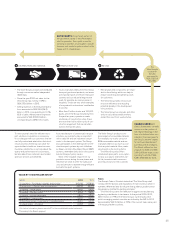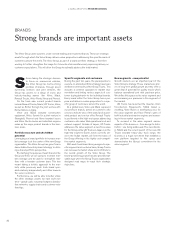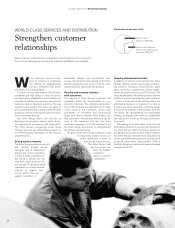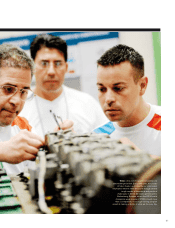Volvo 2013 Annual Report Download - page 36
Download and view the complete annual report
Please find page 36 of the 2013 Volvo annual report below. You can navigate through the pages in the report by either clicking on the pages listed below, or by using the keyword search tool below to find specific information within the annual report.
The Volvo Group’s future success depends on its ability to continue
to deliver innovative solutions and develop technologies that can be
converted into fi nancially viable products and services.
The year 2013 was intense in terms of
product launches, particularly in the
truck business. It involved the Group’s
most extensive product renewal to
date, with a brand new series of Volvo trucks, a
complete, new product program from Renault
Trucks, a brand new range of heavy-duty trucks
for emerging markets with the UD Quester and,
at the end of the year, the Eicher Pro Series was
launched featuring eleven new trucks and
buses. All of these new products were devel-
oped with a focus on fuel effi ciency and cus-
tomer profi tability.
Climate change is one of the greatest
challenges faced by mankind. Research shows
that transport is responsible for approximately
14% of the total greenhouse gas emissions
caused by humans. As one of the world’s larg-
est manufacturers of commercial vehicles, the
Volvo Group works to reduce CO2 emissions
from the use of its products.
Three areas of focus
The Group’s product development is driven by
the cost of and availability of fuel, as well as
legislation in the environmental area. Therefore,
the Volvo Group focuses its research and devel-
opment on the development of energy-effi cient
drivelines, electromobility and vehicles that can
be operated on renewable and alternative fuels.
THREE AREAS OF FOCUS
• Energy-effi cient drivelines
• Electromobility
• Vehicles that can be operated on
renewable fuels.
The Volvo Group also participates in public and
private partnerships to develop sustainable and
effi cient transport systems, such as the Bus
Rapid Transport System (BRT).
Energy-effi cient drivelines
The Volvo Group has a life-cycle perspective
and considers the environmental impact from its
products, from them being developed all the way
to them being phased out and recycled. Since
more than 90% of the environmental im pact
results from the use of the products, the Group’s
main focus is on reducing fuel consumption,
CO2 emissions and other exhaust emissions. The
basic principle is that each new product shall have
less impact on the environment than the product
it replaces.
The Volvo Group estimates the fuel-saving
potential for a standard truck will be about 15%
in 2025 compared with fuel consumption in
2010. New technology can lead to even more
signifi cant savings. For instance, the use of a
hybrid driveline may improve fuel consumption
by up to 39% in certain bus operations. If all
buses were changed to plug-in hybrids, total
energy consumption would be reduced by as
much as 60%.
Electromobility
Hybrid technology is one of the most promising
and competitive new technologies for commer-
cial vehicles. Because of its potential for saving
fuel, hybrid technology means lower operating
costs for customers while at the same time sig-
nifi cantly reducing the environmental impact.
The most appropriate vehicles for hybrid drive-
lines are those operating in continuous stop-go
conditions, such as city buses and refuse or
distribution trucks.
The Volvo Group’s I-SAM concept consists of
an electric motor and a diesel engine working in
parallel, whereby each of them can be used
where they are most effective. Production of
the Volvo Hybrid city bus and the Volvo Hybrid
double-decker started in 2010. Signifi cant fuel
savings make these hybrid buses a commer-
cially viable option.
During the year, Volvo Buses strengthened
its model program with a new articulated bus
that uses hybrid technology. The Volvo 7900
Hybrid Articulated has a capacity of up to 154
passengers, which is more than any other
hybrid bus on the market, and a fuel consump-
tion that is up to 30% lower than current diesel
models. As of 2014, all single-decker, low-fl oor
buses in Volvo Buses’ model program in Europe
are hybrid buses. The hybrid program includes
Volvo 7900 Hybrid (4x2), Volvo 7900 Hybrid
Articulated and Volvo B5LH Double Decker.
Furthermore, Volvo Buses commenced fi eld
studies with plug-in hybrids that indicate that
fuel consumption can be lowered by 80% and
total energy consumption by slightly more than
60%. The fi eld study in Gothenburg started in
May 2013 and includes three plug-in hybrid
buses, whose batteries are charged at the end
stations, which means that a large part of the
route can be powered by electricity.
Sunwin Bus, the Volvo Group’s Chinese joint
venture, together with SAIC Motor, has deliv-
ered 787 full electric buses in total. Volvo Buses
and SAIC Motors also have a joint venture for
developing driveline systems for electric and
hybrid buses.
The Volvo Group has offered two models of
hybrid trucks in selected European markets
since 2011: the Volvo FE Hybrid and the Renault
Premium Hybrys-Tech. Customers have given
very positive feedback on these trucks. The tech-
nology has met their high expectations on both
reliability and performance, reaching the expected
fuel savings of up to 30%. However, total sales
volumes have been low due to the relatively
high additional investment for customers. While
hybrid trucks deliver on the environmental
dimension of sustainability, the business case is
currently unsustainable. The decision not to
develop new versions for Euro 6 was announced
at the end of 2013. The Volvo Group believes in
hybrid technology long-term and will continue
to invest in research and development for more
commercially viable applications. Should demand
for hybrid trucks pick up substantially in the
future, the Group will be in a strong position to
reintroduce the technology.
A perfect solution for distribution and refuse
applications is Renault Trucks’ fully electric Max-
ity Electric, which does not emit any exhaust
fumes and is very quiet. The distribution model of
Maxity Electric has been on the market for just
over three years. In 2013, the offering was
expanded to include a smaller refuse truck
adapted for collecting household garbage.
A GLOBAL GROUP 2013 BUSINESS MODEL
The basic principle is that each new product shall
have less impact on the environment than the product
it replaces.
PRINCIPLES
PRODUCT DEVELOPMENT
Development focusing on
more effi cient products
32
























